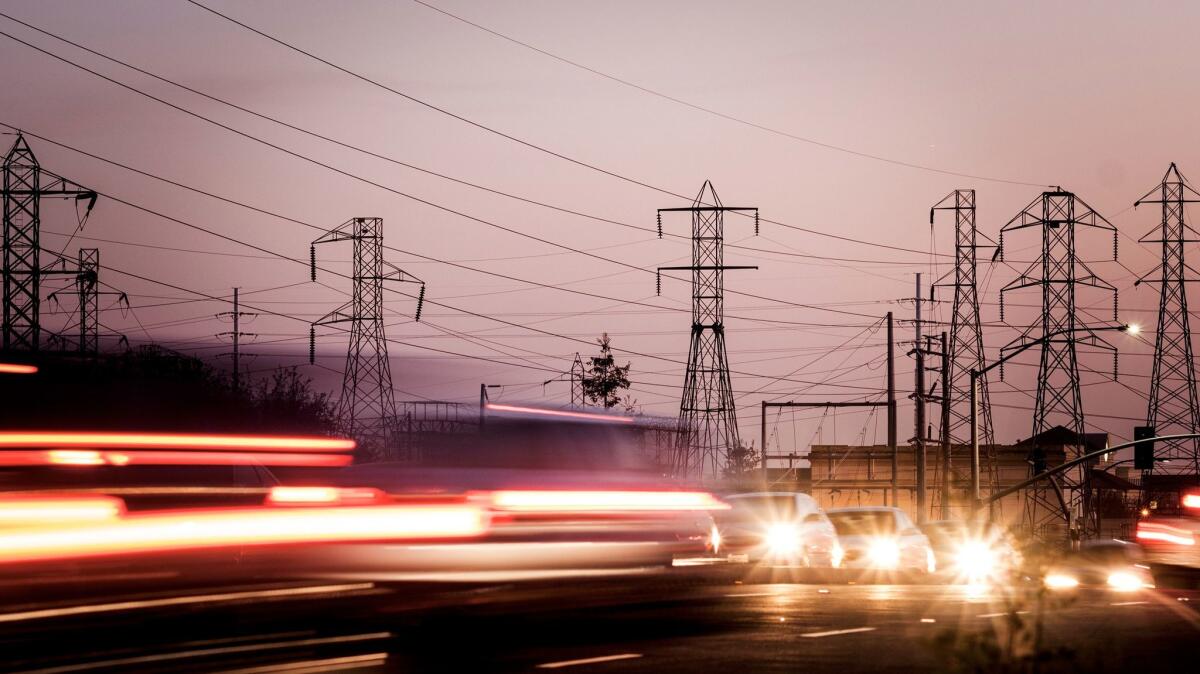Why Wall Street gets a cut of your power bill
- Share via
Eric Hildebrandt first raised the red flag in an annual report written in 2015 for his bosses overseeing California’s electricity market.
He raised the same issue in a 2016 report. And he is raising it again in a recently released 2017 report.
The warning to the California Independent System Operator: Trading by speculators and other investors in an obscure financial instrument pegged to electricity transmission is costing the state’s electricity customers an average of $76 million a year, contributing to higher rates. From 2009 to 2017, Hildebrandt reported to the state, California ratepayers lost almost $700 million, and the tab keeps growing.
While generating profits for investors with returns averaging 146% a year, the trading serves little purpose for energy users and shouldn’t cost consumers a dime, his reports have concluded. Hildebrandt recommends the trading — also cited for its vulnerability to market manipulation akin to the Enron scandal — be terminated.
“It’s not needed,” said Hildebrandt, director of Cal-ISO’s market monitoring division. “Stop subsidizing a free market. Don’t expose the ratepayers to the losses.”
Despite the warnings, the trading has continued with minor modifications. Although the losses over time have narrowed somewhat, the $49 million in losses through the end of October already have exceeded last year’s total for the comparable period by nearly $2 million.

Lax oversight of trading in energy markets, critics contend, is another example of how the state’s regulatory bodies have failed California’s electricity users. Rather than protecting consumers from extreme fluctuations in energy prices when demand spikes, regulations have burdened them with paying for the profits Wall Street collects.
This has added to the cost of electricity, which is already rising rapidly because the state has allowed more power plants to be built than are needed while failing to coordinate the expansion of renewable energy sources. As a result, California consumers are paying 50% more for electricity than the average user in other states — $6.8 billion a year more than just under a decade ago, even though they’re using less electricity.
Critics of California’s energy market say the burden on consumers will only get worse if Cal-ISO’s authority is expanded. Currently, Cal-ISO controls California’s electric grid, but it has proposed broadening its jurisdiction across almost a dozen Western states with eyes toward parts of Canada and Mexico.
Hildebrandt’s concerns are bolstered, those critics say, by recurring attempts at market manipulation by investors. Federal regulators have assessed $1.6 billion in penalties against traders, banks, utilities, power producers and grid operators for various violations since anti-manipulation laws were enacted by Congress in 2005, a Los Angeles Times investigation has found.
More than a third of the assessed penalties have been tied to California’s energy market.

In some ways, banks, financial traders and others have ripped pages from the Enron-era playbook, creating variations on the electricity trading strategies used during the California energy crisis, when schemes named “Get Shorty” and “Death Star” contributed to rolling blackouts.
The biggest penalties involved JP Morgan and Barclays. Federal regulators assessed those two banks more than half a billion dollars, including a $105-million settlement last month with Barclays for alleged trading violations that occurred from 2006 to 2008. The majority of the assessed penalties go into federal coffers, though some fines are awarded to consumers for harm they suffered.
Jon Wellinghoff, a former chairman of the Federal Energy Regulatory Commission, said he believes the system has improved over the last 10 years with increased federal enforcement and stiff penalties.
“I think the banks understood pretty quickly that they couldn’t engage in those kinds of practices,” Wellinghoff said.
But other market players not accused of wrongdoing have tapped high-risk investment opportunities such as the one Hildebrandt is protesting.
Cal-ISO’s transmission-related investment vehicle was created as a hedge against unexpected fluctuations in electricity prices.
In this case, it involves the cost of transmitting electricity over power lines, which is one component in the overall price of electricity. For example, when demand increases dramatically, it can at times lead to congestion on a particular power line, requiring power producers to send electricity a more circuitous — and potentially expensive — route.
Basic economics kicks in: The price of energy rises with increased demand for a power line, like a toll road where fees rise and fall depending on traffic.
By selling something known as congestion revenue rights, Cal-ISO generates money that helps ensure that power plant owners can keep their operations financially afloat — even if transmission prices surge.
The program was supposed to pay for itself, with money from yearly, quarterly and monthly auctions in which investors acquire congestion rights.
But sometimes prices for those rights are as low as $1 or less, which falls short of offsetting the costs to power plant owners and payments to investors. That gap is worsened by savvy investors, who — with mathematicians — have been able to predict and bet on where congestion is most likely to occur. Their winning bets can earn triple-digit returns, which must be covered by the auction sales or, when that falls short, by utilities. The utilities pass those costs on to consumers.
Hildebrandt’s latest report found that ratepayers lost 48 cents per dollar sold in the auction. That has led to the hundreds of millions of dollars in losses, all shouldered by California consumers.
Energy markets in other areas of the country have faced criticism for similar practices that cost consumers.
Keith Casey, Cal-ISO’s vice president for market and infrastructure development, said Cal-ISO, which recently released a report on the program, is reviewing it and hopes to enact a new policy next year.
Casey said the trading is an important tool that provides protection against soaring electricity prices. Losses to consumers, he said, are a small fraction of the annual cost of California’s $8-billion energy market.
“Any draconian change or abolishing [the investment] altogether could have big ramifications,” Casey said.
But critics note that the investment programs have been vulnerable to manipulation by market players.
Michael Rosenberg became a high-stakes gambler in Cal-ISO’s electricity market when he began buying congestion revenue rights almost a decade ago.
Rosenberg, a physicist, benefited from his knowledge of the energy world. He had worked for several power and gas companies, including New England’s electricity grid manager and California shareholder-owned utility Pacific Gas & Electric Co.

In spring 2011, about a decade after the California energy crisis had ended, regulators say, Rosenberg and his then-3-year-old Etracom were losing money on the congestion investment.
Then Rosenberg changed his approach.
Rosenberg bet on electricity flow at the New Melones connection in Northern California, roughly between Stockton and Yosemite National Park. When electricity failed to move in the direction of his bet, Rosenberg, federal investigators say, worked to reroute the flow of electricity, like setting up roadblocks and detour signs to redirect traffic.
Rosenberg fostered the change in power-flow direction by offering to acquire and sell electricity to wholesale users at below-market prices, investigators said.
He lost money selling cheap electricity but made far more from the transmission through New Melones.
Etracom realized exponential growth in revenue, swinging from losses of $2 per megawatt to earnings of $35 a megawatt.
Rosenberg blamed Cal-ISO’s market design and software errors that allowed for his strategy, an argument that regulators rejected.
“Market design flaws do not excuse manipulative conduct and sometimes provide the context for it,” investigators concluded.
Federal regulators have imposed $2.5 million in penalties against Etracom, including $100,000 against Rosenberg. They also ordered more than $315,000 in profits returned to consumers.
Rosenberg continues to dispute the penalties.
“We’re confident that we’ll be able to show we didn’t violate any laws,” said Robert S. Fleishman, Rosenberg’s lawyer, declining to discuss the case further because of the pending litigation.
The penalties are part of more than $1.6 billion in fines that federal regulators have assessed banks, traders, utilities and even electricity grid operators such as Cal-ISO. The penalties reflect the higher scrutiny given to the nation’s energy markets after manipulation of California’s electricity system during the Enron scandal.
Larry Parkinson, director of the Federal Energy Regulatory Commission’s enforcement division, said his department is 10 times larger than it was during the days of Enron, which has enabled better policing of manipulation. In addition, technology has led to tools that investigators didn’t have in the past.
But Parkinson added that “bad actors” always attempt to abuse the complex system — something he does not see going away anytime soon.
Carrie Bentley, a consultant for the Western Power Trading Forum, an association of energy industry participants, said the Cal-ISO Department of Market Monitoring — of which she was once an employee — is being overly aggressive in attacking the congestion revenue rights problem.
She said eliminating the program would jeopardize the stability of the energy market. The financial support the investments provide, Bentley said, helps ensure that there is sufficient funding to keep plants in operation and consumers’ lights on while preventing wild spikes in electricity prices.
“Don’t throw out the baby,” Bentley said.
Instead of scaling back programs, defenders of Cal-ISO’s operations argue, they should grow. They say that expanding Cal-ISO’s programs and operations will improve management of excess solar and wind power and that reducing use of fossil fuels requires the ability to share resources between states. They argue that the larger system will save $1 billion to $1.5 billion a year by 2030.
Ralph Cavanagh, a program co-director at the Natural Resources Defense Council and one of the leading proponents of a single Western grid manager, said that a unified electricity grid operation would bring with it increased scrutiny and, as a result, better transparency and less market manipulation. He said with multiple states involved, there would be more people to review the organization than there are with Cal-ISO today.
Cavanagh said he sees opportunities to create more consumer choice, increase clean energy and cut costs if Cal-ISO expands across the West. Such an expansion could help resolve some of the problems with power line congestion, he said.
“Yes, there are significant congestion issues across the grid right now,” Cavanagh said. But with an expanded Cal-ISO, “we would be paying less for congestion.”
Critics don’t see it that way. And some, such as Parkinson of the Federal Energy Regulatory Commission, go as far as to say that a larger operation invites more potential problems.
“I think almost by definition, the more market participants you have, the more likely it is that some of them may be folks that are trying to exploit loopholes or vulnerabilities in those markets,” Parkinson said.
Who would benefit?
Banks, investors and power companies, said Tyson Slocum, of Washington, D.C.-based consumer advocacy organization Public Citizen.
That would also likely result in more trading pegged to such physical operations as electricity transmission — and potentially even higher trading losses paid at ratepayers’ expense, Slocum said. Those risks should be enough to prompt policy changes and avoid a regional system that’s already proved problematic in the Midwest and the East.
“All of them have poor track records when it comes to transparency, public accountability and ensuring in a transparent process that all stakeholders have equal representation,” Slocum said. “As long as the electricity markets are going to be run by private entities, expanding that is a huge gamble for consumers.”
Times data editor Ben Welsh contributed to this report.
For more energy news, follow Ivan Penn on Twitter: @ivanlpenn
UPDATES:
Dec. 26, 1 p.m.: This story was updated with additional details about the mechanics of trading congestion revenue rights.
This story was originally published on Dec. 14.
More to Read
Inside the business of entertainment
The Wide Shot brings you news, analysis and insights on everything from streaming wars to production — and what it all means for the future.
You may occasionally receive promotional content from the Los Angeles Times.











